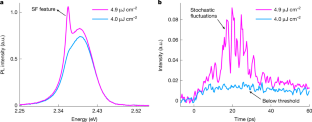2025-05-28 ノースカロライナ州立大学(NCState)
<関連情報>
- https://news.ncsu.edu/2025/05/solitonic-superfluorescence-paves-way-for-high-temperature-quantum-materials/
- https://www.nature.com/articles/s41586-025-09030-x
- https://tiisys.com/blog/2022/04/01/post-104676/
ペロブスカイトからの従来にないソリトーン高温超蛍光 Unconventional solitonic high-temperature superfluorescence from perovskites
Melike Biliroglu,Mustafa Türe,Antonia Ghita,Myratgeldi Kotyrov,Xixi Qin,Dovletgeldi Seyitliyev,Natchanun Phonthiptokun,Malek Abdelsamei,Jingshan Chai,Rui Su,Uthpala Herath,Anna K. Swan,Vasily V. Temnov,Volker Blum,Franky So & Kenan Gundogdu
Nature Published:28 May 2025
DOI:https://doi.org/10.1038/s41586-025-09030-x

Abstract
Fast thermal dephasing limits macroscopic quantum phenomena to cryogenic conditions1,2,3,4 and hinders their use at ambient temperatures5,6. For electronic excitations in condensed media, dephasing is mediated by thermal lattice motion1,7,8. Therefore, taming the lattice influence is essential for creating collective electronic quantum states at high temperatures. Although there are occasional reports of high-Tc quantum effects across different platforms, it is unclear which lattice characteristics and electron–lattice interactions lead to macroscopically coherent electronic states in solids9. Here we studied intensity fluctuations in the macroscopic polarization during the emergence of superfluorescence in a lead halide perovskite10 and showed that spontaneously synchronized polaronic lattice oscillations accompany collective electronic dipole emission. We further developed an effective field model and theoretically confirmed that exciton–lattice interactions lead to a new electronically and structurally entangled coherent extended solitonic state beyond a critical polaron density. The analysis shows a phase transition with two processes happening in tandem: incoherent disordered polaronic lattice deformations establish an order, while macroscopic quantum coherence among excitons simultaneously emerges. Recombination of excitons in this state culminates in superfluorescence at high temperatures. Our study establishes fundamental connections between the transient superfluorescence process observed after the impulsive excitation of perovskites and general equilibrium phase transitions achieved by thermal cooling. By identifying various electron–lattice interactions in the perovskite structure and their respective role in creating collectively coherent electronic effects in solids, our work provides unprecedented insight into the design and development of new materials that exhibit high-temperature macroscopic quantum phenomena.




